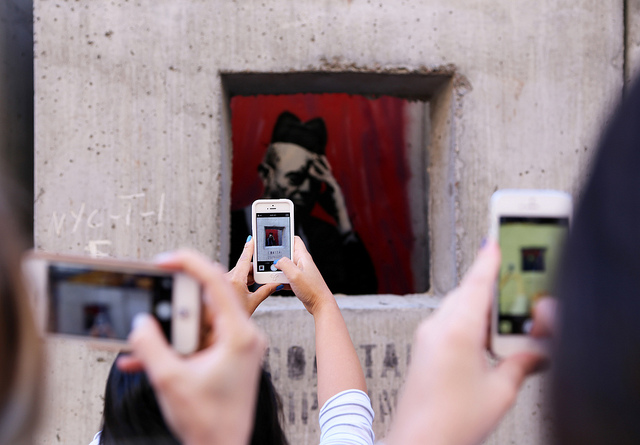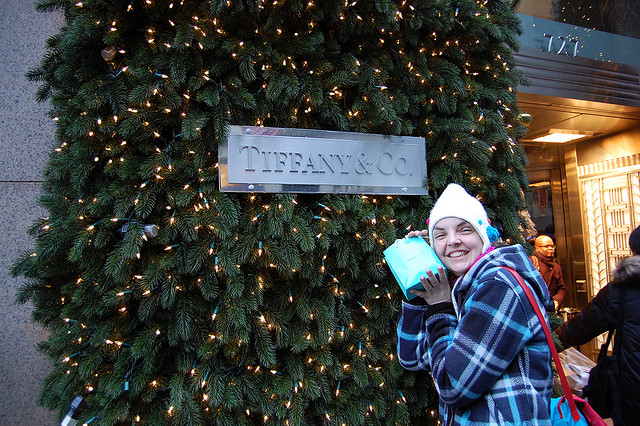Unlock the Magic in Your Story Now
Get the Free 20 questions to Ask Before Launching Your Idea workbook when you sign up for occasional updates.
Get the Free 20 questions to Ask Before Launching Your Idea workbook when you sign up for occasional updates.
Valuable Things We Ignore In The Quest For Growth
filed in Marketing, Storytelling, Strategy
 One of the first words a baby learns to say is ‘more’. They learn very early on that this one word is the shortest route to getting what they want. Every three year old knows that two cupcakes are better than one.
One of the first words a baby learns to say is ‘more’. They learn very early on that this one word is the shortest route to getting what they want. Every three year old knows that two cupcakes are better than one.
It’s no surprise then that this lesson stays with us through life and that we take it into our businesses. We condition ourselves to believe that more followers, more leads and more customers are the key to success.
Growth doesn’t necessarily mean you are growing. If you attract the wrong customers, increase profits at the expense of staff morale, cannot deliver on your promises or create the impact that you’d hoped, are you any further ahead? So when you target growth it pays to think hard about the metric of more and consider a more holistic definition.
Could the best growth strategy for your business be to make the biggest difference to fewer people?
Image by Jessica Lucia.
Share this article
3 Questions To Help Your Business Evolve With Your Customers
filed in Marketing, Storytelling, Strategy
 The sign next to the juice bar announces that waiting is over. “Don’t Line UP. Order on our app.” No interruption to your day required.
The sign next to the juice bar announces that waiting is over. “Don’t Line UP. Order on our app.” No interruption to your day required.
Have you noticed how waiting has gone out of fashion and the slew of products, apps, services and shortcuts that have come to market which are designed to give us back our time?
It’s not just styles that come and go. Cultural shifts and changing expectations mean our customers evolve too. It’s our job to notice the changes, then to understand the wants and needs that might stem from them as a result—perhaps even before they are articulated.
3 QUESTIONS TO HELP YOUR BUSINESS EVOLVE WITH YOUR CUSTOMERS
1. What are your customers doing?
2. What’s stopping them doing what they want to do?
3. How can you help them to do more of that they want to do or less of what they don’t?
Creating something people want is a lot easier (and cheaper) than trying to make them want something. The trick is understanding the future your customers will want to inhabit, sometimes better than they understand it themselves.
Image by drp.
Share this article
The Best Marketing In The World
filed in Marketing, Storytelling, Strategy
 It’s easy to know why the features you built into your products and services are important, but it takes a particular skill to understand and communicate why they should matter to people.
It’s easy to know why the features you built into your products and services are important, but it takes a particular skill to understand and communicate why they should matter to people.
The best marketing in the world doesn’t remind people how great the company is or how many features have been added to the product. The best marketing reminds people how great they are.
Image by Mikael Wiman.
Share this article
How Everything Truly Great Is Inspired
filed in Entrepreneurship, Marketing, Storytelling, Strategy
 This is the story of a trap we all fall into. Every single entrepreneur or creator without exception is thrown off course by following a similar pattern. It doesn’t matter if you are on the board of a Fortune 500 or a designer trying to get her blog off the ground. The same struggle happens at both ends of the spectrum and everywhere in between.
This is the story of a trap we all fall into. Every single entrepreneur or creator without exception is thrown off course by following a similar pattern. It doesn’t matter if you are on the board of a Fortune 500 or a designer trying to get her blog off the ground. The same struggle happens at both ends of the spectrum and everywhere in between.
You’re about to start a project, set up shop, begin blogging, develop a breakthrough product—what’s the first thing you do? You begin looking for inspiration and the first place you look to is your competitors—the people and companies you believe have everything worked out.
But sometimes you forget to stop looking and start doing. You begin to draw on their experience neglecting to build on it by using your own. You subconsciously focus on how hard it’s going to be to catch up, instead of intentionally learning from what they forgot. Their voice, purpose and way of showing up in the world gets louder and grows bigger, while yours seems quieter and smaller, until eventually it’s so muffled that you can’t find it at all. This is the point where some people stop showing up because they don’t gain the traction they had hoped for as a pale imitation of a competitor, influencer or market leader.
The people who stick with it know that there is a place where truly great ideas, writing, design, products, services, platforms and innovations are born, if only we would allow ourselves to tap into them sooner and more often. Everything truly great is inspired by our own stories and experiences—our unique worldviews.
I know for sure that as soon as I began putting more of my own experiences into my writing it got better. So what? Maybe you couldn’t care less about writing? You might want to be CTO of a global corporation, or CEO of the best company in the world? So this is where I draw out my trump card (and everyone else’s too). If we know anything about how Apple succeeded under Steve Jobs we know that he, as my friend James Victore would say, “had an opinion and put it in the work.” He drew inspiration from what he lived and saw other people living, not from what he saw another company do. The following passage from his Stanford Commencement address is worth revisiting.
“And much of what I stumbled into by following my curiosity and intuition turned out to be priceless later on. Let me give you one example:
Reed College at that time offered perhaps the best calligraphy instruction in the country. Throughout the campus every poster, every label on every drawer, was beautifully hand calligraphed. Because I had dropped out and didn’t have to take the normal classes, I decided to take a calligraphy class to learn how to do this. I learned about serif and sans serif typefaces, about varying the amount of space between different letter combinations, about what makes great typography great. It was beautiful, historical, artistically subtle in a way that science can’t capture, and I found it fascinating.
None of this had even a hope of any practical application in my life. But ten years later, when we were designing the first Macintosh computer, it all came back to me. And we designed it all into the Mac. It was the first computer with beautiful typography. If I had never dropped in on that single course in college, the Mac would have never had multiple typefaces or proportionally spaced fonts. And since Windows just copied the Mac, it’s likely that no personal computer would have them. If I had never dropped out, I would have never dropped in on this calligraphy class, and personal computers might not have the wonderful typography that they do.”
Of course everyone knows that Apple is the exception to every rule of success. There’s only one Apple after all and perhaps the same conclusions can’t be drawn in the industry you work in? Except that the Airbnb guys experienced the pain of not making rent, so they started a company unintentionally by renting out the extra space in their apartment. And Mark Zuckerberg created a platform for people like him, without quite realising how lonely the rest of the world was too. Then Dave Gilboa, Co Founder of Warby Parker lost a $700 pair of glasses he couldn’t afford to replace and it got him thinking about why glasses cost as much as an iPhone. The same rules applied in the pre-digital world of Adi Dassler—yes, Adidas got its name from the founder who learned how to make shoes by watching his father who was a cobbler. As an athlete Adi also came to realise that the right equipment could enhance human performance. He went on to design football boots that helped Germany to win the 1954 World Cup and athletic shoes that were responsible for enabling the gold medal winning performances of Jesse Owens and Dick Fosbury.
This isn’t just true in the world of product innovation. Great works or art, design, graffiti and literature from Banksy to Brontë are all inspired by lived experiences or drawn from within.
Your inspiration is all around you in your day to day. Your advantage probably already exists.
You’re just not looking there. Yet.
Image by carnagenyc.
Share this article
How To Communicate Your Difference
filed in Marketing, Storytelling, Strategy
 There is a place where many entrepreneurs, (maybe you) and even global corporations who look like they have got it all together, (maybe yours), get stuck when trying to differentiate themselves in the marketplace. They hit a wall when they begin to articulate what’s unique about what they do and why it should matter to their customers. The reason they get stuck is because they’re starting in the wrong place—by trying to find the words before they work on the understanding.
There is a place where many entrepreneurs, (maybe you) and even global corporations who look like they have got it all together, (maybe yours), get stuck when trying to differentiate themselves in the marketplace. They hit a wall when they begin to articulate what’s unique about what they do and why it should matter to their customers. The reason they get stuck is because they’re starting in the wrong place—by trying to find the words before they work on the understanding.
Difference doesn’t manifest in well-crafted descriptions, value propositions and vision statements that live in A4 files or posters in the sales department. Differentiation isn’t just described or articulated, it’s perceived and felt.
Re-arranging the words that describe you isn’t going to get you to where you want to go.
You need to dig deeper.
And sometimes even when we do know what makes us different we are afraid to own and communicate it. We’re afraid to stand out for being good at that thing that we’re good at, in the precise way that we are good, just in case that’s not enough for everyone. We get scared about putting hearts on business book covers or we worry that choosing to be small on purpose makes us less, when it probably makes us more (maybe even the best driving school in Perth).
The irony is that not being enough for everyone means you’re exactly right for the people who matter. Separating yourself from the pack starts by knowing what you’re proud to stand for and owning it. Once you do that the words will come.
Image by oddharmonic.
Share this article
Showing Up For Humans, Not Just For Google
 I want to send some flowers to a friend a few suburbs away, of course I could deliver them myself, but there is something magical about the unexpected arrival of flowers that means I want to have them delivered. And so I turn to Google.
I want to send some flowers to a friend a few suburbs away, of course I could deliver them myself, but there is something magical about the unexpected arrival of flowers that means I want to have them delivered. And so I turn to Google.
After 20 minutes I find myself on page ten feeling like I have viewed 56,000 of the 57,000 results. Who gets to page ten without finding what they are looking for? I never get to page ten! But all of the florists are the same—at least that’s how they look and sound on Google—see. The formulaic bouquets look like they were assembled in a factory to spec. The frustrating thing is that I know every florist is not the same and I’m trying to find the one that’s had the courage to say we’re not like everyone else.
I want to believe that someone who cared got up before dawn, so he could reach the flower market in time to get his pick of the best blooms on sale today. I imagine him back in his workroom carefully trimming each stem and examining each petal. I conjure up an image of how he assembles every bouquet, choosing each flower on purpose so that no two bunches look alike. And it matters that he cares enough to know that he’s not just delivering flowers today, but that he’s enabling connections between friends or soothing quarrels between lovers.
Whatever you sell or serve if you go to the trouble and expense to be found then don’t make yourself invisible to the person who matters.
Image by Robin Giese.

 When I was fifteen it cost fifty pence to go a see U2 play live to a tiny audience in the function room of the Rathfarnham Inn. A group of girls from my school who were die hard fans and too young to get into a pub at night applied three layers of eyeliner, half a can of hairspray and bluffed their way in every week. Of course once the word was ‘out there’ and U2 became the next big thing the fifty pence gigs came to an end before I was old enough to go. They are still my heroes.
When I was fifteen it cost fifty pence to go a see U2 play live to a tiny audience in the function room of the Rathfarnham Inn. A group of girls from my school who were die hard fans and too young to get into a pub at night applied three layers of eyeliner, half a can of hairspray and bluffed their way in every week. Of course once the word was ‘out there’ and U2 became the next big thing the fifty pence gigs came to an end before I was old enough to go. They are still my heroes. In the past most businesses gained competitive advantage from size, scale or dominance. Whoever the biggest marketing budget and could sell the most stuff won. Success was more about what you did and much less about the way that you did it. But today it’s the way that you go about your business and how you enable people to attach meaning to your brand (soloist or Fortune 100 included) that matters.
In the past most businesses gained competitive advantage from size, scale or dominance. Whoever the biggest marketing budget and could sell the most stuff won. Success was more about what you did and much less about the way that you did it. But today it’s the way that you go about your business and how you enable people to attach meaning to your brand (soloist or Fortune 100 included) that matters. The little gelato place down the road from us is dying. For three years straight they were the only good enough ice cream place in the boat harbour. The lack of competition meant that they could steadily increase their prices from $3.80 per scoop to $5.80 while continuing to staff the store with young, casual, minimum wage workers. Almost $6 for a single scoop of gelato was an indulgence for families on a hot summer night, but they paid it to eat the product in that location.
The little gelato place down the road from us is dying. For three years straight they were the only good enough ice cream place in the boat harbour. The lack of competition meant that they could steadily increase their prices from $3.80 per scoop to $5.80 while continuing to staff the store with young, casual, minimum wage workers. Almost $6 for a single scoop of gelato was an indulgence for families on a hot summer night, but they paid it to eat the product in that location.